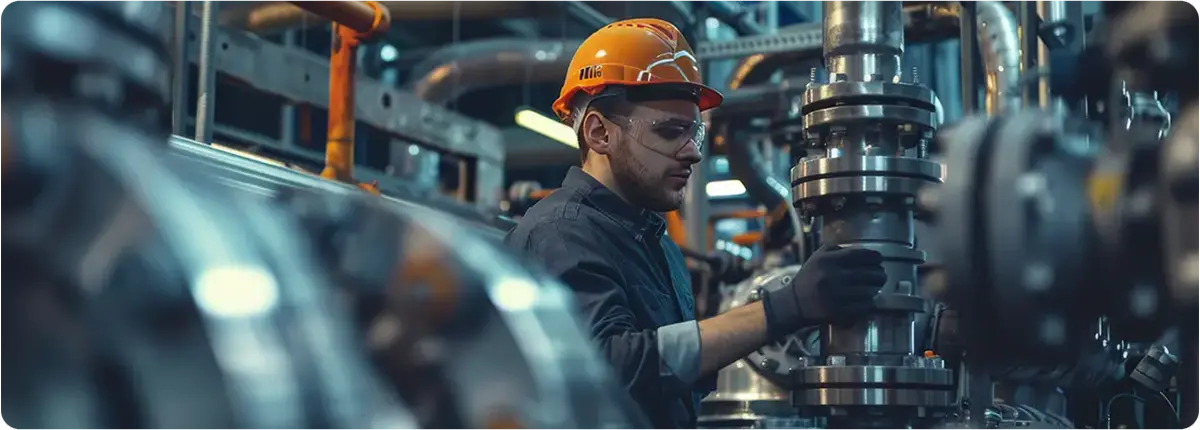Proactive maintenance practices can add years to the operational lifespan of ball valves.
Ball valves are essential components in fluid and gas control systems used across industries such as oil & gas, chemical processing, food and beverage manufacturing, machinery production, and automotive assembly and maintenance.
Compared to gate or globe valves, ball valves are often favored because they offer:
- Compact, cost-efficient designs
- Quick open/close operation
- Reliable performance under high pressure, high volume, and high temperature
- Strong resistance to corrosion and mechanical wear
- Long service life
- Compatibility with a wide range of industrial processes
Most ball valves are designed to require little to no maintenance and are eventually replaced once they reach the end of their service life. However, with the right preventive strategies, it is possible to extend their lifespan by several years, reducing both downtime and replacement costs.

FACTORS INFLUENCING BALL VALVE LIFESPAN
While manufacturers typically estimate the service life of a ball valve at 8–10 years, real-world performance can be extended with proper care. The following factors have the greatest impact:
ACTUATION METHOD
Selecting the correct actuation type improves safety, reduces maintenance expenses, and ensures optimal uptime. Pneumatic actuated ball valves, for example, are highly durable in high-pressure systems as long as a compressed air supply is available.
DESIGN
Ball valves are available in one-piece, two-piece, and three-piece configurations. One- and two-piece designs cannot be repaired—when they fail, they must be replaced. Three-piece designs allow for the removal and replacement of seals and seats without removing the entire valve from the system.
TEMPERATURE AND PRESSURE RATINGS
The closer the operating conditions are to the valve’s maximum temperature and pressure limits, the more frequently maintenance or replacement will be required. High-cycle and high-pressure applications put significantly more stress on valve components.
MEDIA CHARACTERISTICS
Ball valves are designed for clean fluids and gases. Any abrasive particles present in the media can damage the valve’s internal surfaces, leading to leaks or actuator failure.
MATERIAL SELECTION
Common valve body materials include stainless steel, brass, bronze, and PVC. While PVC offers cost advantages and chemical resistance for certain applications, metal valves provide superior durability, higher temperature resistance, and broader media compatibility.
WHY BALL VALVE MAINTENANCE MATTERS
- Extended Lifespan – Valves that last longer reduce replacement frequency, minimize downtime, and improve operational efficiency.
- Safety – Regular inspections and proper installation reduce the risk of accidents, leaks, or catastrophic failures.
- Uninterrupted Production – Many maintenance tasks can be performed without halting operations, keeping production lines active.
- Cost Savings – Preventive maintenance lowers the need for emergency repairs and avoids unplanned capital expenditure.
HOW BALL VALVES WORK
A ball valve uses a spherical ball with a central bore to control flow.
- When the bore aligns with the flow path, the valve is open.
- Rotating the ball 90 degrees closes the valve by blocking the passage.
This quarter-turn operation allows quick shut-off and easy visual confirmation of valve position, but can also cause water hammer if closed too quickly.
PREVENTIVE MAINTENANCE FOR BALL VALVES
To get the best performance and lifespan from ball valves, maintenance should begin before any issues appear. Key steps include:
CORRECT INSTALLATION
Proper installation by trained professionals ensures optimal alignment, sealing, and performance.
REGULAR CLEANING
Annual cleaning (or more often in dusty or dirty environments) prevents buildup that could impair performance.
- Use compressed air or gas-based cleaners for metal components.
- Use alcohol- or water-based cleaners for non-metal parts.
LUBRICATION
Use synthetic, water-resistant, oil-based lubricants to reduce wear and maintain smooth operation. Avoid clay- or solid-based lubricants that can accumulate in the valve cavity.
SCHEDULED INSPECTIONS
Inspections should be carried out at least once a year—or more frequently for high-pressure and high-cycle applications. Checks should include:
- Tightness of all hardware
- Corrosion or mineral buildup
- Leak detection
- Full range of motion testing
- Position indicator accuracy
- Adequate exhaust and filtration conditions in the surrounding area
ANNUAL OVERHAUL
During planned shutdowns, remove valves from service, disassemble them, clean all parts, and replace worn components, especially seals and seats.
CONCLUSION
By selecting the right materials, using appropriate actuation methods, and following a disciplined preventive maintenance plan, ball valves can operate reliably for many years beyond their standard expected lifespan. This not only saves money but also protects plant safety and ensures uninterrupted production.